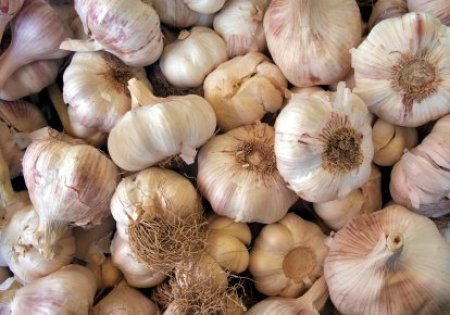
Allium spp.
Garlic
Garlic is a bulb from the Allium family known for its strong, pungent odor and flavor. The bulb is made up of sections of cloves and is commonly used for culinary purposes or its medicinal properties. Garlic is related to, and closely resembles the onion.
mid to early spring as soon as soil is workable
hardy perennial
full sun
Plant garlic in nutrient-rich, well-drained soil in the spring. Plant sets (bulbs) to a depth of 1 to 2 inches and spaced 6 to 8 inches apart. Keep soil evenly moist (not wet) until the green tops begin to die back, then cease watering while bulbs mature. Mildew or rot may be a sign of over-watering. Plants can be side dressed with compost or an organic fertilizer like liquid kelp in the spring.
division of bulbs (cloves)
bulbs (cloves)
well-drained soil
Keep soil evenly moist (not wet) until the green tops begin to die back, then cease watering while bulbs mature. Mildew or rot may be a sign of over-watering.
Plants can be side-dressed with compost or an organic fertilizer like liquid kelp in the spring.
Harvest garlic when 2/3 of the plant's leaves turn brown or the tops fall over and die. Garlic planted in the fall should be ready by June or July and spring planted garlic by the end of the summer. Let bulbs cure in a sunny location for 2 to 3 days. Braid tops together and hang or remove them and hang bulbs in a net bag or nylon stocking.
Garlic is subject to the same disease and pest problems as onions, although the most common problems are rot or mold due to over watering or poor drainage.
Save the biggest, most vigorous bulbs of the season to use for sets next year.
antiseptic; diuretic; anti-oxidant; aids in circulation
Adds flavor to any savory dishes (especially good in Italian and French cooking); oil and vinegars
hair care; insect repellant; companion plants to roses and berries

Add your voice! Click below to comment. ThriftyFun is powered by your wisdom!
We've had such a mild winter here in w. NY that my fall-planted bulbs sprouted in Nov. and have grown slowly all winter long. Weird year. I'm looking forward to seeing how they do until harvest time, wondering if the early start will give them a jump on when they'll be ready.
Add your voice! Click below to comment. ThriftyFun is powered by your wisdom!